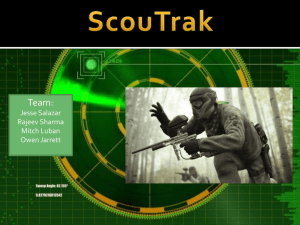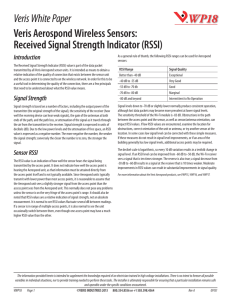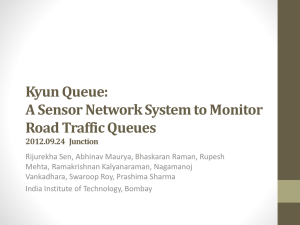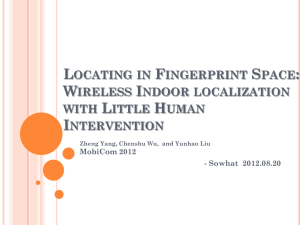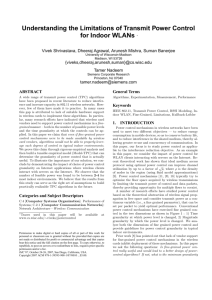Slide 1
advertisement
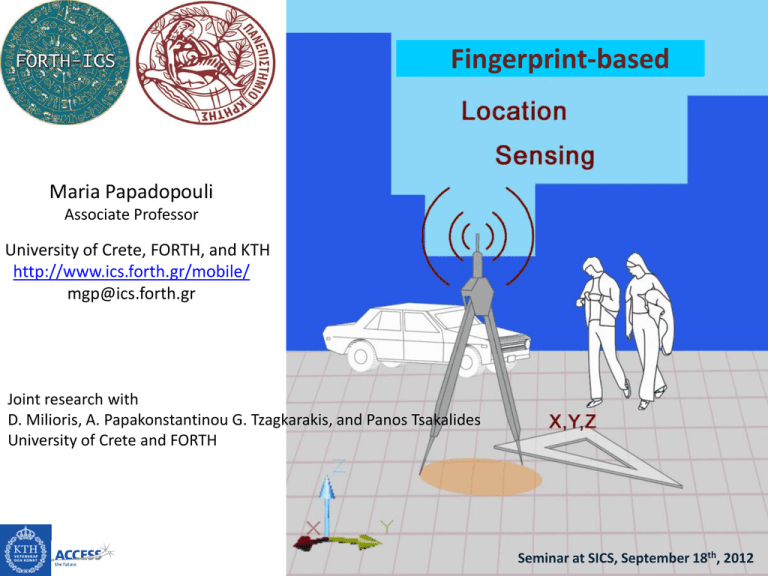
Fingerprint-based
Maria Papadopouli
Associate Professor
University of Crete, FORTH, and KTH
http://www.ics.forth.gr/mobile/
mgp@ics.forth.gr
Joint research with
D. Milioris, A. Papakonstantinou G. Tzagkarakis, and Panos Tsakalides
University of Crete and FORTH
Seminar at SICS, September 18th, 2012
Plethora of social networking location-based applications
Fast growth of location-based services
e.g., 74% of US smartphone owners use location-based services
Several positioning systems have been proposed
Taxonomy of Positioning Systems
•
•
•
•
•
•
•
Infrastructure & hardware
Signal modalities
• Radio
(Radar, Ubisense,
Ekahau)
Models
& algorithms
for estimating
distances, orientation, position
• Infraredsystem,
(Active scale
Badge)
Coordination
and position description
• Ultrasonic (Cricket, Active Bat)
Localized or remote computations
• Bluetooth
Mechanisms
for device identification, classification or recognition
• Vision (EasyLiving)
Physical contact
with requirements
pressure (smart floor) or touch sensors
Cost,•accuracy
& precision
The main points of our research in positioning.
• Use fingerprinting & design various statistical fingerprints
Not all fingerprints are created equal !
• Getting real!
Challenges when experimenting under real-world scenarios
• The power of compressive sensing
Received Signal Strength Indicator
No standardized relationship of any particular physical parameter to RSSI
No defined relationship between RSSI value & power level in mW or dBm
Vendors provide their own accuracy, granularity, and range for the actual
power (measured as mW or dBm) and their range of RSSI values (from 0 to
RSSI_Max).
RSSI is acquired during only the preamble stage of receiving an 802.11 frame,
not over the full frame
Received Channel Power Indicator(RCPI) measures the received RF power in a
selected channel over the preamble and the entire received frame, and has
defined absolute levels of accuracy and resolution
The simplicity of RSSI Fingerprinting
•
•
•
•
Grid-based representation of physical space (cells)
RSSI measurements collected from various APs @ cells of the space
Design of the fingerprint
Two phases: the training and the runtime
– Generation of fingerprints based on measurements collected at each
phase
• Estimated position: the cell whose training fingerprint has the minimum
distance from the runtime one
RSSI Statistical Fingerprinting for Positioning
Signal-strength measurements per AP
AP1
cell
User
position
APk
Training-phase fingerprint
comparison
Distance of that cell
Run-time fingerprint
Examples of RSSI Statistical Fingerprints
•
•
•
•
•
Confidence intervals
Percentiles
Empirical distribution of the RSSI measurements
Theoretical distributions (e.g., Multivariate Gaussian)
Compressive sensing
Fingerprint based on Percentiles
i
T j (c) : vector with the percentiles based on the RSSI measurements
collected during the training phase from i-th AP at cell c
Euclidian distance
number of percentiles
jth training percentile
from the ith AP for cell c
number of APs
Distance of cell c
jth run-time percentile from the ith AP
Alternatively, K-Top weighted percentiles:
Weighted centroid of the K cells with the smallest distance
Fingerprint based on Empirical Distribution
• A vector whose entries correspond to APs
• Each entry composed by all the RSSI measurements collected per AP
• Only APs that appear in both training and runtime are used
• Distance: average Kullback-Leibler Divergence (KLDs)
• Reported position: the cell with the smallest distance
Statistical Fingerprint based on Confidence Interval
Each AP assigns a weight to cells based on the
relative “placement” of the training vs. runtime confidence intervals
AP i assigns weight w(t) to cell t
Fingerprint based on Multivariate Gaussian
•
•
•
•
Multivariate Gaussian for RSSI measurements collected from APs
Closed-form Kullback-Leibler Divergence (KLD) for distance estimation
Exploits the 2nd order spatial correlations between APs
Improves accuracy by iterating in multiple spatial scales (regions)
Multivariate Gaussian Distribution
Signature of cell i in training phase:
–
–
mean values of the received RSSI measurements per AP
: covariance matrix (measure of spatial correlation)
Signature of a cell in runtime phase:
APs from which measurements were collected at both training &
runtime phases
Multi-layer Multivariate Gaussian Approach
Main idea:
• Divide physical space into overlapping regions
• Apply multivariate Gaussian model in each region
• Select the region with the minimum distance
Iteratively
• Divide the selected region into sub-regions
• Repeat the process in that region
until the current region becomes a cell
The region-based aggregation and iterative process helps to
• eliminate an incorrect region
• increase the weight of the correct region
Experiment
and it will lead you to the light
Cole Porter, 1930
Getting Real: Deployment of Testbeds.
At different premises:
• Lab & hallway at FORTH: 7m x 12m
10 APs (~ 5.4 on average @ cell)
cell size 55cm x 55cm
Under different conditions:
• Aquarium: 1760m2, 40 tanks
7 APs (~ 3.4 on average @ cell)
cell size 1m x 1m
• Topological layout
• Presence of people or visitors
quiet vs. busy periods
Evaluation of RSSI Fingerprint Approaches
But what do we REALLY learn from these experiments ?
Fingerprinting is nice, but the devil is in the detail.
• Pathologies in fingerprint comparisons
Sensitivity to the variations in RSSI measurements
• Large size of data that need to be sent by energy-constrained devices
• When you suppress the noise-like features, do you still maintain the
prominent information content?!
• Complexity and convergence issues
Robustness with respect to RSSI Variations
Not all fingerprints are created equal: some are less robust than others.
Pathology in the comparison of confidence interval fingerprints:
Sensitivity to the relative position of their endpoints (boundaries) :
Even a small “displacement” may affect the value of the contribution
assigned to a specific cell
Αι δεύτεραι πως φροντίδες σοφώτεραι.
Ευριπίδης, 480-306 π.Χ.
Second thoughts are–in most cases–wiser.
Euripides, 480-306 BC
Lots of Measurements: Energy consumption vs. Accuracy
Sparsity: the transform coefficients vector has a small number of large
amplitude coefficients and a large number of small amplitude coefficients
Several natural signals are often sparse in a discrete cosine transformation or
in a Fourier basis
Example:
The 50 Hz powerline signal is sparse in the frequency-domain
Warming-up with Compressive Sensing
x: the vector with measurements
x : expressed in terms of the Ѱ basis x = Ѱ w, w: coefficients vector
x is K-sparse in Ѱ if it can be represented by K elements of this basis
Theorem:
if x is K-sparse, it can be reconstructed from M non-adaptive linear projections onto a second
measurement basis (M = r K << N)
Compressive sensing in context
x: the vector with the RSSI measurements – x is not sparse
x can be expressed in terms of the Ѱ basis: x = Ѱ w
Ѱ: created at training
compressed form of x
Φ: measurement matrix
Standard Gaussian
Fixed
Optimization problem: find the w: indicator vector {0,1}
w: indicator vector {0,1}
w is sparse
run-time
RSSI measurements
run-time
measurement matrix
compressed form
of run-time
measurements
Lessons Learned; Thou shalt not ignore radio propagation.
• The prominent impact of the presence of people and AP placement on
accuracy.
•
A proper pre-processing of the RSSI measurements is required.
•
The ability to suppress the noise-like features is important.
• Reduce the amount of data sent to suppress the noise-like features but
maintain the prominent information content!
• The iterative multi-layer spatial approach improves the accuracy by
– eliminating distant incorrect cells
– considering the neighboring cells around the user position
Summarizing the performance results …
• With less than 20% measurements, a reasonable accuracy can be achieved
using compressive sensing (e.g., OMP)
Quiet Period
Busy Period
Premise
MvG
OMP
MvG
OMP
FORTH
1.09
1.08
1.10
1.08
Aquarium
1.48
1.09
4.15
3.59
• For the L1-norm optimization problem:
Select an algorithm based on the convergence vs. accuracy tradeoff
Δεί τά μέλλοντα τοίς γεγενημένοις τεκμαίρεσθαι.
Ισοκράτης, 436-338 π.Χ.
Insight into future events is based on what happened in the past.
Isocrates, 436-338 BC
Exploring the Power of Compressive Sensing
• New transform & measurement bases that are adaptive to the specific
characteristics of the RSSI data
•
Exploit the random nature of the measurement vectors for encryption
without the extra computational cost of a separate encryption protocol
Exploring other directions
• Employing various modalities to enhance the accuracy
• Reconsidering the problem of cooperative localization …
More information at
http://www.ics.forth.gr/mobile/
Thank you!
Who is afraid of real-life measurements?
At different premises:
• FORTH: 7m x 12m
10 APs (~ 5.4 on average @ cell)
cell size 55cm x 55cm
• Aquarium: 1760m2, 40 tanks
7 APs (~ 3.4 on average @ cell)
cell size 1m x 1m
Under different conditions:
• Presence of people or visitors
relatively quiet vs. busy periods
• Topological layout
Quiet Period
Premise
MvG
OMP
Busy Period
MvG
OMP
FORTH
1.09
1.08
1.10
1.08
Aquarium
1.48
1.09
4.15
3.59
Lessons Learned;
How the estimations per AP are used
• CS-based approach is carried out for each AP separately, using the
compressed RSSI measurements, and the final estimate is given by the
centroid of the individual estimated positions
• The confidence interval, percentiles, and empirical distributions perform an
averaging over all APs of the values of the corresponding distance function
before the final location estimation
• E.g., in the case of empirical distribution:
Each cell is assigned a weight which corresponds to the average KLD of each
AP (at that cell) from the runtime measurements collected at the unknown
position from the same AP.
Two cells with different KLD values between the individual APs may be
reported erroneously to be close to each other after taking the average KLD,
since the average operator eliminates the distinct contribution of each
separate AP
Fingerprinting based on Multivariate Gaussian (cnt’d)
• Mean sub-vectors
and covariance sub-matrices
are extracted according to
• Multivariate Gaussian density function:
• KLD between runtime and training of the ith cell:
Estimated position: cell with minimum KLD
• Design of new transform and measurement bases that are adaptive to the specific
characteristics of the RSSI data.
• A new sparsifying basis being able to increase the degree of sparsity of an RSSI
measurements vector, represented in terms of this basis, is critical in the framework of CS,
since the reconstruction accuracy increases as the sparsity increases.
• An improved performance can be guaranteed with high probability by employing an
appropriate measurement matrix, which is highly incoherent with the sparsifying basis.
Who is afraid of real-life measurements?
Evaluation of RSSI Fingerprint Approaches
Fingerprinting is nice, but the devil is in the detail.
• Pathologies in fingerprint comparisons
• Sensitivity to the variations in RSSI measurements
• Size of data that need to be exchanged!
energy constraints of mobile devices
